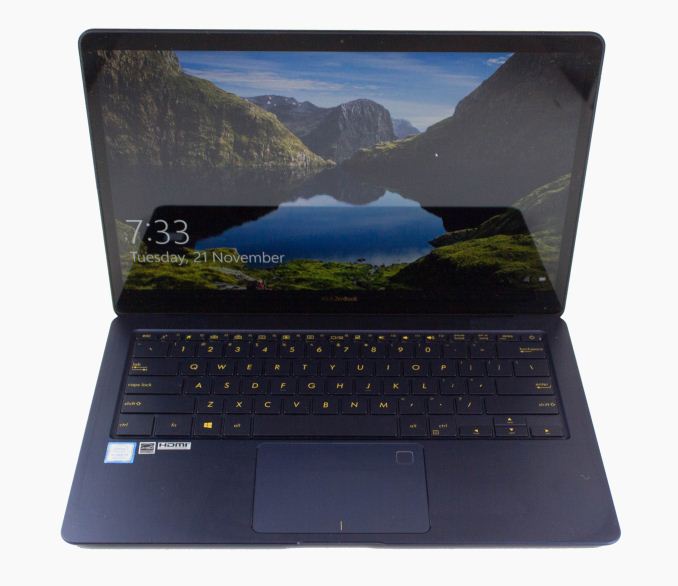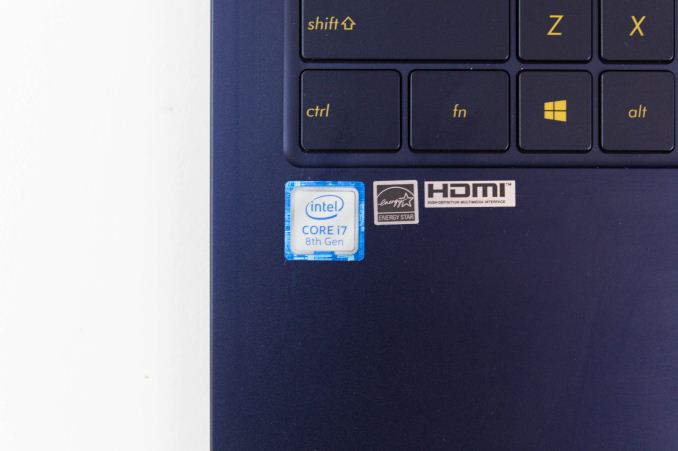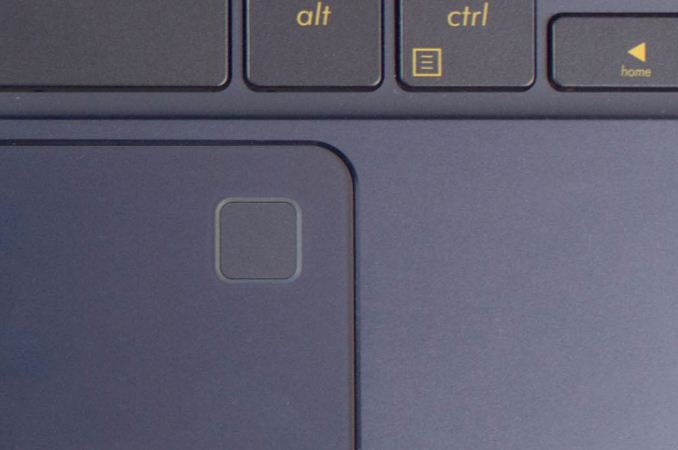The ASUS ZenBook 3 Review: A Convincing Case for Quad Core Thin & Light Laptops
by Brett Howse on November 22, 2017 8:00 AM EST- Posted in
- Laptops
- Asus
- Zenbook
- Core 8th Gen
- Kaby Lake Refresh

ASUS is a company that doesn’t shy away from the latest technology, and with the new ZenBook 3 UX490UA, they’ve updated one of their thinnest and lightest machines to include the latest Intel 8th Generation processors. It’s likely no surprise to any of our readers what this means, but for those who are just now dipping their toes into Intel's newest processors, this is Kaby Lake Refresh, which features the first ever quad-core ultramobile Core processor from Intel. ASUS in turn has packed Intel's latest processor into a small, lightweight chassis, with all of the features expected in a modern Ultrabook.
With the ASUS ZenBook 3, the company currently offers two models. The original ZenBook 3, which ASUS continues to offer, features a Core i7-7500U CPU, a dual-core hyperthreading-enabled CPU with a base of 2.7 GHz and boost of 3.5 GHz. Joining the family with the launch of Kaby Lake Refresh is a new model based around a Core i7-8550U CPU, which is the new quad-core with hyperthreading, running at a base frequency of 1.8 GHz and boosting up to 4.0 GHz. Relative to the 7500U model, the 8550U model's base frequency is a bit lower to accommodate the extra cores, but for workloads without as many threads, the 4.0 GHz top boost speed is a big jump over the 3.5 GHz top speed of the previous generation chip.
Today we're taking a look at the newer 8550U-based model. Given that it's a minor refresh of the existing ZenBook 3 design, a lot of the focus is going to be on the new CPU, and for good reason. While Intel's 8th generation Core lineup is unfortunately a bit of a mess (more on that in a bit), but it's a significant update at almost every level of Intel's product stack, thin & light ultrabooks included. Whereas all Intel 15 Watt CPUs before now have been dual-core designs, Kaby Lake Refresh bumps that up to a quad-core, which as we'll see makes for some rather potent performance boosts in even moderately threaded scenarios. This in turn is a rather significant development for Ultrabooks: the thin & light laptops have always been about tradeoffs – giving up performance and some ports for portability – however the release of a quad-core CPU suitable for these laptops means that Ultrabooks can now reach into performance tiers previously restricted to larger laptops.
Not that the ZenBook 3 is all about its CPU, of course. As mentioned previously, ASUS has not shied away from packing in all the latest tech either. The ZenBook 3 UX490UA features a 14-inch 1920x1080 IPS panel, with thin display bezels, allowing the laptop to be much more compact that older 14-inch models would be. They’ve outfitted the laptop with 16 GB of LPDDR3 memory, and 256 GB of SATA SSD, or 512 GB of PCIe 3.0 x 4 NVMe storage.
| ASUS ZenBook 3 UX490UA | |||||
| Model Tested: Core i7-8550U, 512GB SSD, $1699 | |||||
| Processor | Intel Core i7-7500U (2C/4T, 2.7-3.5 GHz 15W) Intel Core i7-8550U (4C/8T, 1.8-4.0GHz, 15W) |
||||
| Memory | 16 GB Dual-Channel LPDDR3-2133 | ||||
| Graphics | 7500U: Intel HD 620 (24 EUs, 300MHz-1.05GHz) 8550U: Intel UHD 620 (24 EUs, 300MHz-1.15GHz) |
||||
| Display | 14" 1920x1080 16:9 IPS Corning Gorilla Glass 5 Non-Touch 100% sRGB color |
||||
| Storage | 256GB SATA / 512GB NVMe | ||||
| Networking | 802.11ac, 2x2:2, 866Mbps Max, 2.4 and 5GHz Bluetooth 4.1 Intel Dual Band Wireless-AC 8265 |
||||
| Audio | Quad-speakers Harman Kardon Certified |
||||
| Battery | 46 Wh, 65 W AC Adapter USB-C Charging | ||||
| Right Side | USB-C w/Thunderbolt 3 USB-C 3.1 Gen 1 (5Gbps) with Display and Power Delivery |
||||
| Left Side | 3.5mm Headset Jack USB-C w/Thunderbolt 3 |
||||
| Dimensions | 329 x 210 x 12.9 mm (12.95 x 8.279 x 0.51 inches) | ||||
| Weight | 1.1 kg / 2.42 lbs | ||||
| Cameras | VGA Web Cam | ||||
| Pricing | Core i7-7500U $1579 USD Core i7-8550U $1699 USD |
||||
Some laptops are still debating whether to offer USB-C, but ASUS has gone all-in with two Thunderbolt 3-equipped USB-C ports and a further standard USB 3.1 Gen 1 (5 Gbps) port. All three USB-C ports offer upstream charging, while the Thunderbolt ports add TB3 data speeds, dual 4K display output, and USB 3.1 Gen 2 (10 Gbps) data transfer capabilities to the mix. Wireless connectivity is provided by an Intel Dual Band Wireless-AC 8265 adapter. This is one of the most reliable ones available, and offers excellent 2x2:2 performance, but also MU-MIMO and Bluetooth 4.1.
ASUS has even found room for a fingerprint reader, which allows Windows Hello login.
Although ASUS lists a 256 GB model, it doesn't appear to be for sale anywhere at the moment.
ASUS packs all of this into a laptop that’s only 1.1 kg / 2.42 lbs, and 12.9 mm / 0.51 inches thick. It’s available in both a striking Royal Blue, or a Quartz Gray finish on the “aerospace-grade aluminum alloy” which ASUS says is 50% stronger than the standard aluminum alloy.
Let’s dig into the design and see how they did.












55 Comments
View All Comments
lefty2 - Wednesday, November 22, 2017 - link
The Cinebench multithread score look very weak. Only 497. The Ryzen 2700U scores 707Dr. Swag - Wednesday, November 22, 2017 - link
When it's allowed to turbo to the max, that is. If you put it in a laptop where you're more thermal and power constrained it's gonna give similar performance to this.If you look here it's only scoring 550 or so
https://images.anandtech.com/doci/11964/amd_ryzen_...
The 700 number was definitely with good cooling and maybe even the CPU set to the 25w mode. To achieve over 700 the CPU would need to be boosting to 3.3 ish ghz which is not reasonable to see in a laptop.
lefty2 - Wednesday, November 22, 2017 - link
(Sorry, posted this wrong)The 707 score is for a 15w laptop. Also, some redditors benchmarked the envy x360, which has a ryzen 5 2500u, that scored 577
neblogai - Wednesday, November 22, 2017 - link
Did Anandtech run Cinebench on Asus a single time, or in long loop? Did not see the answer when fast-reading the article. Ryzen Mobile in HP x360 with 2500U scored up to 614 for users in a single run, and AMD showed ~550 to be expected in continuous load at 25W. However- this Asus is a laptop weighing only half of what HP x360 weighs, thus lower cTDP/shorter boost time is reasonable.DanNeely - Wednesday, November 22, 2017 - link
Not sure, but in the power analysis section of the article it stated that after an initial burst the laptop dropped its CPU power down to 15W; so falling behind a 25W system is only to be expected. The graph in that section's bobbing up and down on temp/clock speed/etc suggests it was run long enough to reach steady state at least.lefty2 - Wednesday, November 22, 2017 - link
It's a pity no review site wants to buy a Envy x360 and benchmark it properly. We could lay this to rest thenRyan Smith - Wednesday, November 22, 2017 - link
Our Envy is on its way.=)lefty2 - Wednesday, November 22, 2017 - link
Excellent!jjj - Thursday, November 23, 2017 - link
Hope you guys spend a bit of extra time on power (for just the RR SoC), it's a possible weak point given how little such data AMD shared.Krysto - Wednesday, November 22, 2017 - link
And how do we know this isn't this laptop's "peak performance", too? Maybe Intel's chip actually drops down to a score of 300 after it throttles...